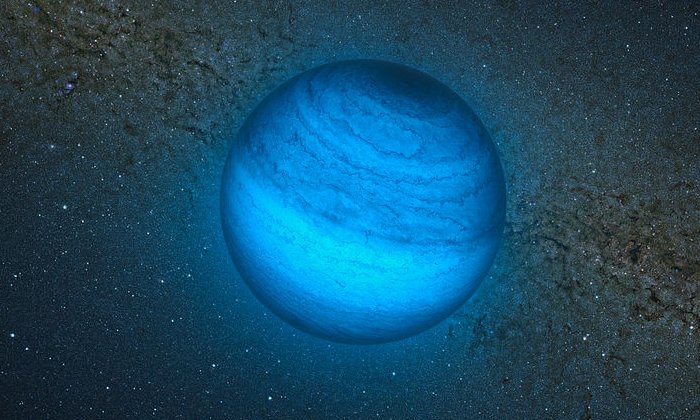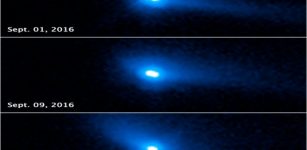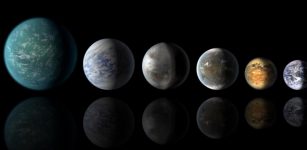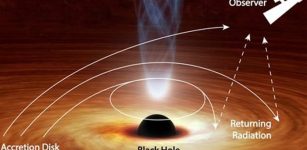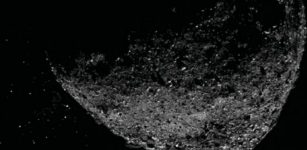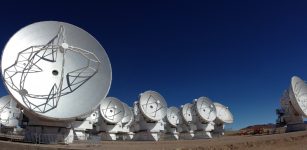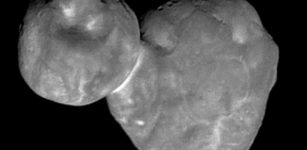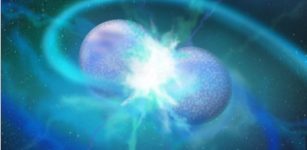“Free-Floating” Planets: Kepler Delivers Evidence For Mysterious Population
Eddie Gonzales Jr. – MessageToEagle.com – Tantalizing evidence has been uncovered for a mysterious population of “free-floating” planets, planets that may be alone in deep space, unbound to any host star.
Researchers used data obtained in 2016 during the K2 mission phase of NASA’s Kepler Space Telescope. During this two-month campaign, Kepler monitored a crowded field of millions of stars near the center of our Galaxy every 30 minutes in order to find rare gravitational microlensing events.
This artist’s impression shows the free-floating planet CFBDSIR J214947.2-040308.9. This is the closest such object to the Solar System. It does not orbit a star and hence does not shine by reflected light; the faint glow it emits can only be detected in infrared light. Here we see an artist’s impression of an infrared view of the object with an image of the central parts of the Milky Way from the VISTA infrared survey telescope in the background. The object appears blueish in this near-infrared view because much of the light at longer infrared wavelengths is absorbed by methane and other molecules in the planet’s atmosphere. In visible light the object is so cool that it would only shine dimly with a deep red color when seen close-up. Image credit: L. Calçada/P. Delorme/R. Saito/ – CC BY 4.0
The study team led by Iain McDonald of the University of Manchester, UK, (now based at the Open University, UK) found 27 short-duration candidate microlensing signals that varied over timescales of between an hour and 10 days. Many of these had been previously seen in data obtained simultaneously from the ground.
The study – published today in Monthly Notices of the Royal Astronomical Society – includes four new discoveries that are consistent with planets of similar masses to Earth.
However, the four shortest events are new discoveries that are consistent with planets of similar masses to Earth. These new events do not show an accompanying longer signal that might be expected from a host star, suggesting that these new events may be free-floating planets. Such planets may perhaps have originally formed around a host star before being ejected by the gravitational tug of other, heavier planets in the system.
Predicted by Albert Einstein 85 years ago as a consequence of his General Theory of Relativity, microlensing describes how the light from a background star can be temporarily magnified by the presence of other stars in the foreground. This produces a short burst in brightness that can last from hours to a few days. Roughly one out of every million stars in our Galaxy is visibly affected by microlensing at any given time, but only a few percent of these are expected to be caused by planets.
Kepler was not designed to find planets using microlensing, nor to study the extremely dense star fields of the inner Galaxy. This meant that new data reduction techniques had to be developed to look for signals within the Kepler dataset.
“These signals are extremely difficult to find. Our observations pointed an elderly, ailing telescope with blurred vision at one the most densely crowded parts of the sky, where there are already thousands of bright stars that vary in brightness, and thousands of asteroids that skim across our field,” Iain said.
“From that cacophony, we try to extract tiny, characteristic brightenings caused by planets, and we only have one chance to see a signal before it’s gone. It’s about as easy as looking for the single blink of a firefly in the middle of a motorway, using only a handheld phone.”
According to co-author Eamonn Kerins of the University of Manchester, “Kepler has achieved what it was never designed to do, in providing further tentative evidence for the existence of a population of Earth-mass, free-floating planets. Now it passes the baton on to other missions that will be designed to find such signals, signals so elusive that Einstein himself thought that they were unlikely ever to be observed. I am very excited that the upcoming ESA Euclid mission could also join this effort as an additional science activity to its main mission.”
Written by Eddie Gonzales Jr. MessageToEagle.com Staff

